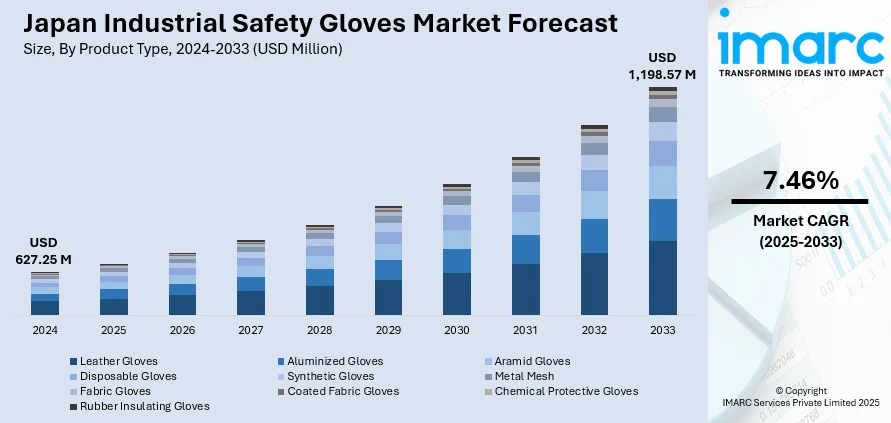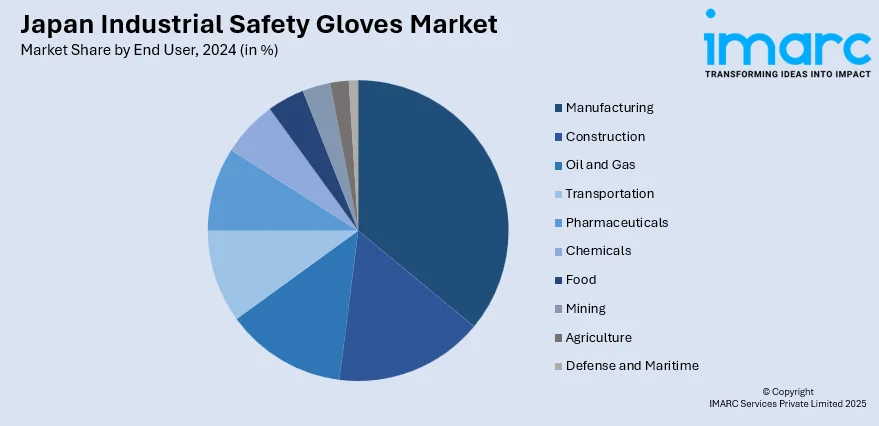
Japan Industrial Safety Gloves Market Size, Share, Trends and Forecast by Product Type, End User, and Region, 2025-2033
Japan Industrial Safety Gloves Market Overview:
The Japan industrial safety gloves market size reached USD 627.25 Million in 2024. Looking forward, IMARC Group expects the market to reach USD 1,198.57 Million by 2033, exhibiting a growth rate (CAGR) of 7.46% during 2025-2033. The market is witnessing significant growth due to strong workplace safety standards, a mature manufacturing sector, and rising demand from electronics, automotive, and healthcare industries. Growing emphasis on precision work and worker protection is driving adoption of high-quality, ergonomically designed gloves. Technological innovation and focus on compliance with stringent regulations are further boosting market penetration, contributing to the overall Japan industrial safety gloves market share.
|
Report Attribute
|
Key Statistics
|
|---|---|
|
Base Year
|
2024
|
|
Forecast Years
|
2025-2033
|
|
Historical Years
|
2019-2024
|
| Market Size in 2024 | USD 627.25 Million |
| Market Forecast in 2033 | USD 1,198.57 Million |
| Market Growth Rate 2025-2033 | 7.46% |
Japan Industrial Safety Gloves Market Trends:
Rising Use in Healthcare and Laboratory Settings
The demand for industrial safety gloves in Japan is seeing notable growth within healthcare, biotechnology, and laboratory environments. These sectors require strict adherence to hygiene, contamination control, and personnel safety, driving the consistent use of disposable and chemical-resistant gloves. For instance, in October 2024, INTCO Medical showcased its innovative medical consumables at MEDICAL JAPAN 2024 in Tokyo, highlighting its focus on the Japanese market. Notably, the Disposable Synmax Vinyl Gloves drew attention for their superior durability compared to traditional gloves, marking a significant advancement in safety and comfort for medical professionals in Japan. Hospitals, diagnostic labs, pharmaceutical firms, and research institutions are increasingly relying on nitrile and latex gloves for procedures involving biological materials, hazardous substances, or sterile environments. The COVID-19 pandemic further reinforced the importance of PPE in medical settings, creating long-term behavioral shifts and higher baseline demand. Additionally, Japan’s strong emphasis on public health and infection prevention has led to the institutionalization of glove use in both clinical and non-clinical settings. This rising adoption, supported by regulatory oversight and safety standards, is positioning healthcare and laboratory applications as a significant contributor to the country’s industrial safety gloves market growth.

Growing Focus on High-Tech Materials and Coatings
Japan's industrial safety gloves market is increasingly driven by advancements in high-tech materials and specialized coatings that enhance protection and durability. Industries such as automotive, electronics, and chemicals require gloves with advanced properties, including high cut resistance, heat insulation, and chemical protection. Manufacturers are responding by introducing gloves made from aramid fibers, nitrile blends, and composite materials that combine strength with flexibility. Innovative coatings improve grip, tactile sensitivity, and resistance to oils and solvents, making gloves suitable for precision work in demanding environments. For instance, in May 2023, Japan's TOWA Corporation unveiled its new NanoFinish coating technology for industrial gloves at the London Safety & Health Expo. The innovation enhances grip and flexibility for dry applications. Currently offered on general-purpose gloves, the company aims to expand this technology to cut, thermal, and chemical-resistant gloves in the future. Additionally, multilayered construction and seamless knit designs are improving glove fit and comfort, promoting greater worker compliance. The adoption of such advanced gloves is becoming more widespread as companies prioritize both safety and productivity. These innovations are playing a key role in supporting Japan industrial safety gloves market growth, especially in high-risk and specialized work environments.
Japan Industrial Safety Gloves Market Segmentation:
IMARC Group provides an analysis of the key trends in each segment of the market, along with forecasts at the country and regional levels for 2025-2033. Our report has categorized the market based on product type and end user.
Product Type Insights:
- Leather Gloves
- Aluminized Gloves
- Aramid Gloves
- Disposable Gloves
- Synthetic Gloves
- Metal Mesh
- Fabric Gloves
- Coated Fabric Gloves
- Chemical Protective Gloves
- Rubber Insulating Gloves
The report has provided a detailed breakup and analysis of the market based on the product type. This includes leather gloves, aluminized gloves, aramid gloves, disposable gloves, synthetic gloves, metal mesh, fabric gloves, coated fabric gloves, chemical protective gloves, and rubber insulating gloves.
End User Insights:

- Manufacturing
- Construction
- Oil and Gas
- Transportation
- Pharmaceuticals
- Chemicals
- Food
- Mining
- Agriculture
- Defense and Maritime
A detailed breakup and analysis of the market based on the end user have also been provided in the report. This includes manufacturing, construction, oil and gas, transportation, pharmaceuticals, chemicals, food, mining, agriculture, and defense and maritime.
Regional Insights:
- Kanto Region
- Kansai/Kinki Region
- Central/Chubu Region
- Kyushu-Okinawa Region
- Tohoku Region
- Chugoku Region
- Hokkaido Region
- Shikoku Region
The report has also provided a comprehensive analysis of all the major regional markets, which include Kanto Region, Kansai/Kinki Region, Central/Chubu Region, Kyushu-Okinawa Region, Tohoku Region, Chugoku Region, Hokkaido Region, and Shikoku Region.
Competitive Landscape:
The market research report has also provided a comprehensive analysis of the competitive landscape. Competitive analysis such as market structure, key player positioning, top winning strategies, competitive dashboard, and company evaluation quadrant has been covered in the report. Also, detailed profiles of all major companies have been provided.
Japan Industrial Safety Gloves Market News:
- In October 2024, SHOWA, a Japanese leader in industrial gloves, launched the MFT PRO series, featuring advanced microfiber technology for enhanced comfort and performance. The line reduces environmental impact with recyclable packaging and offers durability through machine washability. This innovation builds on the legacy of SHOWA's trusted hand protection solutions.
- In April 2024, SHOWA launched eight innovative gloves tailored for various industries, focusing on protective, cut-resistant, and anti-static features. Key models, including the XC 500 and XC 800, offer superior safety and comfort with high cut resistance, flexibility, and touchscreen compatibility, catering to high-risk work environments like automotive and electronics.
Japan Industrial Safety Gloves Market Report Coverage:
| Report Features | Details |
|---|---|
| Base Year of the Analysis | 2024 |
| Historical Period | 2019-2024 |
| Forecast Period | 2025-2033 |
| Units | Million USD |
| Scope of the Report |
Exploration of Historical Trends and Market Outlook, Industry Catalysts and Challenges, Segment-Wise Historical and Future Market Assessment:
|
| Product Types Covered | Leather Gloves, Aluminized Gloves, Aramid Gloves, Disposable Gloves, Synthetic Gloves, Metal Mesh, Fabric Gloves, Coated Fabric Gloves, Chemical Protective Gloves, Rubber Insulating Gloves |
| End Users Covered | Manufacturing, Construction, Oil and Gas, Transportation, Pharmaceuticals, Chemicals, Food, Mining, Agriculture, Defense and Maritime |
| Regions Covered | Kanto Region, Kansai/Kinki Region, Central/Chubu Region, Kyushu-Okinawa Region, Tohoku Region, Chugoku Region, Hokkaido Region, Shikoku Region |
| Customization Scope | 10% Free Customization |
| Post-Sale Analyst Support | 10-12 Weeks |
| Delivery Format | PDF and Excel through Email (We can also provide the editable version of the report in PPT/Word format on special request) |
Key Questions Answered in This Report:
- How has the Japan industrial safety gloves market performed so far and how will it perform in the coming years?
- What is the breakup of the Japan industrial safety gloves market on the basis of product type?
- What is the breakup of the Japan industrial safety gloves market on the basis of end user?
- What is the breakup of the Japan industrial safety gloves market on the basis of region?
- What are the various stages in the value chain of the Japan industrial safety gloves market?
- What are the key driving factors and challenges in the Japan industrial safety gloves?
- What is the structure of the Japan industrial safety gloves market and who are the key players?
- What is the degree of competition in the Japan industrial safety gloves market?
Key Benefits for Stakeholders:
- IMARC’s industry report offers a comprehensive quantitative analysis of various market segments, historical and current market trends, market forecasts, and dynamics of the Japan industrial safety gloves market from 2019-2033.
- The research report provides the latest information on the market drivers, challenges, and opportunities in the Japan industrial safety gloves market.
- Porter's five forces analysis assist stakeholders in assessing the impact of new entrants, competitive rivalry, supplier power, buyer power, and the threat of substitution. It helps stakeholders to analyze the level of competition within the Japan industrial safety gloves industry and its attractiveness.
- Competitive landscape allows stakeholders to understand their competitive environment and provides an insight into the current positions of key players in the market.
Need more help?
- Speak to our experienced analysts for insights on the current market scenarios.
- Include additional segments and countries to customize the report as per your requirement.
- Gain an unparalleled competitive advantage in your domain by understanding how to utilize the report and positively impacting your operations and revenue.
- For further assistance, please connect with our analysts.
 Request Customization
Request Customization
 Speak to an Analyst
Speak to an Analyst
 Request Brochure
Request Brochure
 Inquire Before Buying
Inquire Before Buying




.webp)




.webp)












